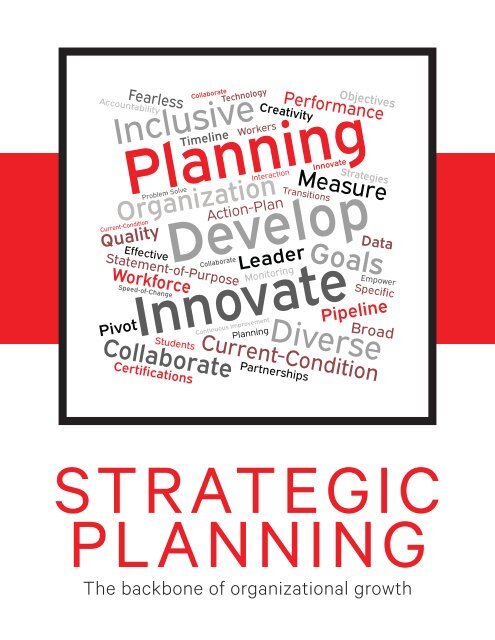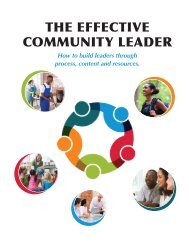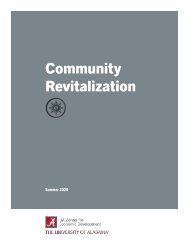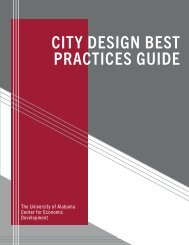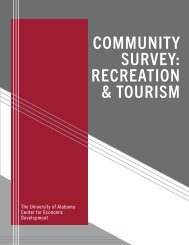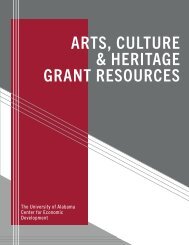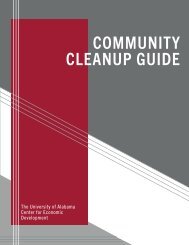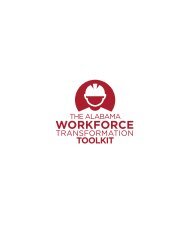Strategic Planning Guide
You also want an ePaper? Increase the reach of your titles
YUMPU automatically turns print PDFs into web optimized ePapers that Google loves.
STRATEGIC<br />
PLANNING<br />
The backbone of organizational growth
“The strategic planning process has been vital for the improvement of Lawrence County Schools, especially<br />
in the area of career technical education. Our strategic planning process involved community members and<br />
stakeholders. These groups worked together on a shared vision, which was concerned with how the<br />
organization should look and how it should function. Our strategic plan serves a guide and a roadmap on the<br />
journey to a successful career tech program. In turn, our plan is an accountability piece for all involved. It<br />
helps ensure movement is occurring and this movement is on the correct path.”<br />
Jon Bret Smith, Ed.D.<br />
Superintendent<br />
Lawrence County Schools<br />
“All leaders and team members of any organization need a playbook for success. The Chickasaw City Schools<br />
<strong>Strategic</strong> Plan Committee convened 28 months ago. We developed a focus for our school system that every<br />
employee understands and pursues. Each person has an ‘elevator speech’ to share with stakeholders and<br />
new employees to keep the mission of Chickasaw City Schools at the forefront. <strong>Strategic</strong> planning has<br />
enabled our school system to define who we are, where we are, and more importantly, our destination. I owe a<br />
debt of gratitude to The University of Alabama Center for Economic Development for their leadership as we<br />
developed our strategic plan.”<br />
David Wofford<br />
Superintendent<br />
Chickasaw City Schools<br />
“If you fail to plan, you are planning to fail.”<br />
Benjamin Franklin
STRATEGIC PLANNING<br />
The backbone of organizational growth<br />
<strong>Strategic</strong> planning is a process to define long term direction, make decisions, and allocate resources to<br />
meet organizational goals. There are many ways to approach strategic planning. In most cases, however,<br />
the use of simple terms and simple processes will move organizations and individuals toward their<br />
collective goals in a concise and seamless manner.<br />
When beginning the process of strategic planning, organizations must be inclusive of all team members<br />
who will work on the plan. A diverse team will allow the organization to benefit from the talents of the<br />
individual members. Representatives of all employment levels of the organization should be at the table,<br />
with conscious thought given to diversity of gender, race, culture, etc.<br />
<strong>Strategic</strong> plans usually contain several parts:<br />
1. Assessment of the Organization<br />
This assessment describes the current condition of the organization. What are the data telling you about<br />
your organization, the conditions that affect the work, and the conditions that affect the workforce, etc.?<br />
2. Statement of Purpose<br />
<strong>Strategic</strong> plans are developed with an end in mind. Many organizations elect to develop vision and mission<br />
statements. These statements take much time and energy to develop and many times become a jumble of<br />
words that even those with the highest aspirations have trouble interpreting and therefore reaching. Why not<br />
develop a simple “statement of purpose” that, with a few words, tells you exactly where you want to be upon<br />
implementation of the plan?<br />
Example of a statement of purpose for<br />
a school district that developed its<br />
strategic plan to ensure that students<br />
were education- and work-ready upon<br />
completion of their K-12 experience:<br />
“Preparing ALL students for success<br />
the day after graduation.”<br />
<strong>Strategic</strong> <strong>Planning</strong> <strong>Guide</strong> — 1
3. Goals<br />
Goals are broad statements that are measurable and that when achieved will indicate accomplishment of the<br />
stated purpose for which the plan was written.<br />
4. Objectives<br />
Objectives are measurable targets written in observable terms. Objectives help define the work that must<br />
be accomplished. Objectives are specific and build toward accomplishing the established goals.<br />
5. Strategies<br />
Strategies are activities implemented to achieve objectives. Strategies break objectives down into small<br />
pieces and show success when these components are aggregated.<br />
6. Accountability (Action Plan/Timeline)<br />
This is the part of the plan that holds individuals or groups responsible for implementation and completion of<br />
plan components. This section contains the specific actions that individuals or groups will be responsible for<br />
and the timeline within which activities are to occur.<br />
7. Accountability (Monitoring)<br />
Organizations are only as strong as the people in the organization. Monitoring refers to the process by which<br />
peer reviews take place in a judgment free environment, so that team members feel confident to present<br />
their work and move toward success. The old adage that “we must inspect what we expect” is true in this<br />
phase of strategy development and implementation.<br />
8. Accountability (Continuous Improvement)<br />
It is not uncommon for strategic plans to be developed and then find their place on the shelf to collect dust.<br />
<strong>Strategic</strong> plans should be the direct route to continuous improvement. <strong>Strategic</strong> plans are no longer developed<br />
for a three-, five-, or ten-year period. Strategy work has to evolve at the “speed of change” in our society,<br />
work, community or life. As business, work, government, community, family, etc. change, so should the plans<br />
change/evolve to help organizations remain viable.<br />
9. Occurrences That May Cause You to Pivot<br />
Situations may occur in work and communities that are completely out of the control of those in<br />
leadership roles. Some examples are the COVID-19 pandemic, natural disasters like tornadoes, the<br />
loss of a major employer, etc. These events affect citizens in general, employers, employees, schools,<br />
churches, etc. The strategic plan should be a roadmap to starting the process for rebuilding in a<br />
proactive rather than reactive way.<br />
2 — <strong>Strategic</strong> <strong>Planning</strong> <strong>Guide</strong>
STRATEGIC PLANNING<br />
<strong>Planning</strong> and development of/for a community requires that individuals understand the components<br />
that must be considered and how these components work together. Figure 1 shows the components of<br />
community development.<br />
Your Community<br />
Your Region<br />
| | | | | | |<br />
Government Human Resources Business Development Quality of Life<br />
Community<br />
Development<br />
Corporation<br />
Environment /<br />
Historic Preservation<br />
Community<br />
Involvement<br />
| | | | | | |<br />
Police Education Retail Healthcare Development<br />
Nature Preserves &<br />
Sanctuaries<br />
Churches<br />
| | | | | | |<br />
Fire<br />
Workforce<br />
Housing /<br />
Adaptive Reuse of<br />
Commercial<br />
Redevelopment<br />
Development<br />
Neighborhoods<br />
Historic Buildings<br />
Civic Groups<br />
| | | | |<br />
Water/Sewer Industry Recreation Highest & Best Use Volunteers<br />
| | | |<br />
Roads Tourism Libraries Nonprofits<br />
| | |<br />
Public Buildings<br />
Entrepreneurs /<br />
Incubators<br />
Arts and Culture<br />
|<br />
Industrial/Business<br />
Parks<br />
|<br />
Airports<br />
Figure 1<br />
Figure 1: Communities have an organizational structure that is dependent on the people (human resources).<br />
For communities to grow and prosper, local leaders must determine their goals for the near and long terms<br />
and implement activities to reach their goals. Some communities are what they are because it “just happened.”<br />
These communities haven’t owned their destinies, and the result may be less than it could have been with<br />
good planning. Other communities have decided what their niche is going to be and have blossomed as a<br />
result with population growth and good jobs to support a high quality of life for their citizens. This makes<br />
maximum use of the human resource component of community development.<br />
The strategic planning process allows for the assessment of the organization, a deep dive into the factors<br />
that affect its growth and development. Following are some examples of data sets that should be considered<br />
when planning for community growth, economic growth and workforce development, including schools.<br />
These three growth sectors cannot be considered in isolation. They must work together to ensure quality of<br />
life for citizens.<br />
Community development cannot occur without economic development, and economic development cannot<br />
occur without workforce development that ensures that workers have the capacity to produce goods and<br />
services. All three components must be working simultaneously to see success overall.<br />
<strong>Strategic</strong> <strong>Planning</strong> <strong>Guide</strong> — 3
Steps for Developing the Plan<br />
Figure 2 shows the steps for developing a strategic plan. Following these nine steps will ensure that a<br />
comprehensive plan is developed and monitored to completion.<br />
Steps for Developing a <strong>Strategic</strong> Plan<br />
STEP<br />
STEP 1 – Assessment<br />
STEP 2 – Statement of Purpose<br />
STEP 3 – Goals<br />
STEP 4 – Objectives<br />
STEP 5 – Strategies<br />
STEP 6 – Action Plan<br />
STEP 7 – Monitoring<br />
STEP 8 – Continuous Improvement<br />
STEP 9 – Pivot Points<br />
WHAT?<br />
What is the data telling you about your current<br />
condition?<br />
What defines the optimum for your organization or<br />
community?<br />
What must be accomplished to reach your optimum?<br />
What are the measurable targets?<br />
What are the broad activities that when accomplished<br />
will help to achieve an objective?<br />
What are the specific actions to be taken based<br />
on the strategies?<br />
What are your performance levels?<br />
(accountability/evaluation)<br />
Are you moving forward based on what you accomplish<br />
and learn? (Can’t be OK with status quo.)<br />
What would cause you to pivot? (Natural disaster,<br />
pandemic, loss of major employer, etc.) How will you be<br />
proactive rather than reactive?<br />
Figure 2<br />
Figure 2: Nine steps for strategic planning.<br />
4 — <strong>Strategic</strong> <strong>Planning</strong> <strong>Guide</strong>
STEP 1 – ASSESSMENT<br />
It is important to understand your community at a particular point in time, like a snapshot. This is called the<br />
“current condition.” The assessment described in figure 3 requires a deep dive into the data.<br />
Steps for Developing a <strong>Strategic</strong> Plan<br />
STEP<br />
STEP 1 – Assessment<br />
WHAT?<br />
What is the data telling you about your current<br />
condition?<br />
Figure 3<br />
Figure 3: There are multiple data points available from a multitude of sources. The UA Center<br />
for Economic Development and the UA Center for Business and Economic Research are good sources.<br />
Below are data sets that are helpful to understanding the current condition of a community. This is not an<br />
exhaustive list. To make these points, we have chosen a case study of Covington County, Alabama.<br />
Data sets important to community development include the following:<br />
1. Who makes up the population? Understand the population by demographic (age, gender, race,<br />
ethnicity, etc.).<br />
DEMOGRAPHIC SUMMARY<br />
Covington County, AL<br />
INCOME<br />
Geography: County<br />
$44,536<br />
Median Household<br />
Income<br />
$24,704<br />
Per Capita Income<br />
$110,476<br />
Median Net Worth<br />
KEY FACTS<br />
200000+<br />
37,970<br />
Population<br />
44.7<br />
Median Age<br />
150000-199999<br />
100000-149999<br />
15,693<br />
Households<br />
$37,551<br />
Median Disposable Income<br />
75000-99999<br />
50000-74999<br />
EDUCATION<br />
35000-49999<br />
EMPLOYMENT<br />
15%<br />
No High<br />
School<br />
Diploma<br />
38%<br />
High School<br />
Graduate<br />
31%<br />
Some College<br />
16%<br />
Bachelor's/Grad/Prof<br />
Degree<br />
25000-34999<br />
15000-24999<br />
0-14999<br />
0<br />
1,000<br />
HOUSEHOLD INCOME<br />
2,000<br />
White Collar<br />
Blue Collar<br />
Services<br />
56%<br />
35%<br />
9%<br />
6.0%<br />
Unemployment<br />
Rate<br />
Figure 4a<br />
<strong>Strategic</strong> <strong>Planning</strong> <strong>Guide</strong> — 5
POPULATION BY AGE<br />
14<br />
12<br />
10<br />
Percent<br />
8<br />
6<br />
4<br />
2<br />
0<br />
0-4 5-9 10-14 15-19 20-24 25-34 35-44 45-54 55-64 65-74 75-84 85+<br />
Figure 4b<br />
2021<br />
2026<br />
80<br />
70<br />
60<br />
2021 POPULATION BY RACE<br />
Percent<br />
50<br />
40<br />
30<br />
20<br />
10<br />
0<br />
White Black Am. Ind. Asian Pacific Other Two+<br />
2021 Percent Hispanic Origin: 2.0%<br />
Figure 4c<br />
VARIABLE<br />
COVINGTON COUNTY, AL<br />
2021 Total Population 37,970<br />
2021 Male Population 18,506<br />
2021 Median Male Age 42.7<br />
2021 Female Population 19,464<br />
2021 Median Female Age 46.5<br />
Figure 4d<br />
6 — <strong>Strategic</strong> <strong>Planning</strong> <strong>Guide</strong>
2. What is the educational attainment level of citizens? Understand the numbers associated with people<br />
earning degrees (high school diplomas, two- or four-year degrees, technical skills and credentials of<br />
value, terminal/professional degrees). Understand the commonalities; for example, is there a higher<br />
number of people who specialize in certain occupations, such as STEM occupations or advanced<br />
manufacturing?<br />
COUNTY PER CAPITA INCOME, 2019<br />
$30,000<br />
$25,000<br />
$20,000<br />
$15,000<br />
$10,000<br />
$5,000<br />
$0<br />
$18,473<br />
Barbour<br />
$21,038<br />
Butler<br />
$27,806<br />
$23,687 $24,563 $24,645 $25,276 $27,097<br />
$21,711 $22,453 $23,675<br />
Coffee Covington Crenshaw Dale Geneva Henry Houston Pike Southeast<br />
HIGH SCHOOL GRADUATE OR HIGHER, 2015-2019<br />
100%<br />
80%<br />
73.2%<br />
85.0% 85.9% 83.4% 79.2%<br />
86.1%<br />
80.3% 79.4%<br />
86.0% 85.0% 82.4%<br />
60%<br />
40%<br />
20%<br />
0%<br />
Barbour<br />
Butler<br />
Coffee<br />
Covington<br />
Crenshaw<br />
Dale<br />
Geneva<br />
Henry<br />
Houston<br />
Pike<br />
Southeast<br />
BACHELOR’S DEGREE OR HIGHER, 2015-2019<br />
25%<br />
20%<br />
15%<br />
10%<br />
11.6%<br />
16.1%<br />
22.8%<br />
15.3%<br />
17.4% 18.1%<br />
12.5%<br />
17.1%<br />
21.7%<br />
23.7%<br />
17.6%<br />
5%<br />
0%<br />
Barbour<br />
Butler<br />
Coffee<br />
Covington<br />
Crenshaw<br />
Dale<br />
Geneva<br />
Henry<br />
Houston<br />
Pike<br />
Southeast<br />
Source: US Census Bureau Quickfacts<br />
The University of Alabama Center for Economic Development<br />
Figure 5a<br />
<strong>Strategic</strong> <strong>Planning</strong> <strong>Guide</strong> — 7
TABLE 6.8 INDUSTRY MIX (FIRST QUARTER 2019)<br />
Industry by 2-digit NAICS code<br />
Total<br />
Employment<br />
Share<br />
Rank<br />
Average<br />
Monthly<br />
Wage<br />
Average<br />
Monthly<br />
New Hire<br />
Earnings<br />
11 Agriculture,Forestry,Fishing and Hunting 2,233 1.70% 15 $3,129 $2,764<br />
21 Mining 215 0.16% 20 $4,564 $4,473<br />
22 Utilities 2,248 1.71% 14 $8,554 $4,599<br />
23 Construction 4,879 3.72% 10 $3,456 $3,060<br />
31-33 Manufacturing 22,996 17.5% 1 $3,717 $2,601<br />
42 Wholesale Trade 4,939 3.8% 9 $4,336 $3,251<br />
44-45 Retail Trade 17,115 13.0% 3 $2,340 $1,552<br />
48-49 Transportation and Warehousing 6,887 5.2% 6 $3,772 $3,007<br />
51 Information 1,018 0.8% 17 $3,796 $2,251<br />
52 Finance and Insurance 3,048 2.3% 12 $4,578 $2,929<br />
53 Real Estate and Rental and Leasing 1,243 0.9% 16 $3,235 $2,193<br />
54 Professional,Scientific,and Technical Services 3,977 3.0% 11 $4,115 $2,684<br />
55 Management of Companies and Enterprises 762 0.6% 19 $3,626 $2,228<br />
56 Administrative and Support and Waste<br />
Management and Remediation Services<br />
5,566 4.2% 8 $2,049 $1,687<br />
61 Educational Services 11,857 9.0% 5 $3,301 $1,842<br />
62 Health Care and Social Assistance 19,920 15.2% 2 $3,412 $2,545<br />
71 Arts,Entertainment,and Recreation 775 0.6% 18 $1,186 $679<br />
72 Accommodation and Food Services 12,181 9.3% 4 $1,153 $983<br />
81 Other Services (except Public Administration) 2,695 2.1% 13 $2,618 $1,764<br />
92 Public Administration 6,739 5.13% 7 $2,749 $1,934<br />
ALL INDUSTRIES 131,291 100.00% $3,179 $2,059<br />
Source: Alabama Department of Labor and U.S. Census Bureau.<br />
Figure 5b<br />
TOTAL POPULATION 25+ WITH A BACHELOR’S DEGREE OR HIGHER<br />
1500<br />
13%<br />
1200<br />
900<br />
1209<br />
903 917<br />
23%<br />
30%<br />
12%<br />
600<br />
474<br />
517<br />
22%<br />
300<br />
0<br />
Science and<br />
Engineering<br />
Science and<br />
Engineering<br />
Related Fields<br />
Business<br />
Education<br />
Arts,<br />
Humanities<br />
and Others<br />
Arts, Humanities and Others<br />
Education<br />
Business<br />
Science and Engineering Related Fields<br />
Science and Engineering<br />
Source: https://data.census.gov/cedsci/table?q=education&g=0500000US01039&tid=ACSST5Y2019.S1502<br />
The University of Alabama Center for Economic Development<br />
Figure 5c<br />
8 — <strong>Strategic</strong> <strong>Planning</strong> <strong>Guide</strong>
2500<br />
2000<br />
1500<br />
1000<br />
500<br />
739<br />
HEALTH SCIENCE<br />
including CNA, CPCT, EKG<br />
1198<br />
1692<br />
2455<br />
1949<br />
3000<br />
2500<br />
2000<br />
1500<br />
1000<br />
500<br />
CONSTRUCTION TRADES<br />
including Welding, HVAC,<br />
Electrical, and Carpentry<br />
2831<br />
1798 2093 2360 2389<br />
1000<br />
800<br />
600<br />
400<br />
200<br />
INFORMATION TECHNOLOGY<br />
including Microsoft MTA,<br />
CompTIA, PC Pro, Security Pro, C-TECH<br />
120<br />
337<br />
729<br />
829<br />
513<br />
0<br />
500<br />
400<br />
300<br />
200<br />
100<br />
2015<br />
2016<br />
2017<br />
2018<br />
2019<br />
MANUFACTURING<br />
including NIMS, AC/DC,<br />
NCCER MECH, NCCER ELECTRICAL<br />
243<br />
376<br />
423 408 393<br />
0<br />
300<br />
200<br />
100<br />
2015<br />
2016<br />
2017<br />
2018<br />
2019<br />
STEM<br />
including AutoCAD, Revit,<br />
Solid Edge, SOLIDWORKS, Autodesk Inventor<br />
600<br />
588<br />
1200<br />
529 516<br />
500<br />
1000<br />
429<br />
400<br />
800<br />
127<br />
0<br />
600<br />
400<br />
200<br />
2015<br />
2016<br />
2017<br />
2018<br />
2019<br />
TRANSPORTATION<br />
including ASE Maintenance & Repair,<br />
ASE Diesel, ICAR, Briggs & Stratton<br />
1046<br />
1110<br />
666<br />
842<br />
815<br />
0<br />
2015 2016 2017 2018 2019<br />
0<br />
2015 2016 2017 2018 2019<br />
Source: https://www.alabamactso.org/wp-content/uploads/2020/07/Alabama-CTE-Impact-Report-2019-2020.pdf<br />
0<br />
2015 2016 2017 2018 2019<br />
The University of Alabama Center for Economic Development<br />
Figure 5d<br />
INDUSTRY EMPLOYED PERCENT US PERCENT LOCATION QUOTIENT<br />
Total 16,023 100.0% 100.0% -<br />
Agriculture/Forestry/Fishing 594 3.7% 1.3% 2.85<br />
Mining/Quarrying/Oil & Gas 343 2.1% 0.4% 4.20<br />
Construction 1,414 8.8% 7.1% 1.19<br />
Manufacturing 2,634 16.4% 9.9% 1.55<br />
Wholesale Trade 349 2.2% 2.5% 0.88<br />
Retail Trade 1,811 11.3% 10.7% 1.16<br />
Transportation/Warehousing 830 5.2% 5.1% 1.11<br />
Utilities 513 3.2% 0.9% 3.56<br />
Information 156 1.0% 1.8% 0.56<br />
Finance/Insurance 628 3.9% 5.2% 0.80<br />
Real Estate/Rental/Leasing 157 1.0% 1.9% 0.48<br />
Professional/Scientific/Tech 659 4.1% 8.3% 0.50<br />
Management of Companies 0 0.0% 0.1% 0.00<br />
Admin/Support/Waste Management 899 5.6% 3.7% 1.44<br />
Educational Services 962 6.0% 9.3% 0.62<br />
Health Care/Social Assistance 1,999 12.5% 14.8% 0.83<br />
Arts/Entertainment/Recreation 142 0.9% 1.5% 0.56<br />
Accommodation/Food Services 534 3.3% 5.9% 0.59<br />
Other Services (Excluding Public) 573 3.6% 4.5% 0.78<br />
Public Administration 826 5.2% 5.2% 1.08<br />
Source: ESRI, Civilian Labor Profile, Covington County<br />
Figure 5e<br />
Figures 5a-5e: Planners must understand income levels, graduation levels, degree attainment,<br />
credential attainment and specialty occupations such as STEM and advanced manufacturing.<br />
<strong>Strategic</strong> <strong>Planning</strong> <strong>Guide</strong> — 9
MEDIAN HOUSEHOLD INCOME, 2019<br />
Florala<br />
$27,944<br />
Covington<br />
Southeast<br />
$42,189<br />
$42,676<br />
Alabama<br />
$50,536<br />
United States<br />
$62,843<br />
$0 $10,000 $20,000 $30,000 $40,000 $50,000 $60,000 $70,000<br />
EDUCATIONAL ATTAINMENT, POPULATION 25+, 2019<br />
15%<br />
17%<br />
37%<br />
Covington County<br />
Less than<br />
High School<br />
Bachelor's Degree<br />
or Higher<br />
8%<br />
20%<br />
42%<br />
Florala Town<br />
Less than<br />
High School<br />
Bachelor's Degree<br />
or Higher<br />
31%<br />
Some College<br />
or Associates<br />
High School<br />
or GED<br />
30%<br />
Some College<br />
or Associates<br />
High School<br />
or GED<br />
Source: 2019 American Community survey 5-year estimates<br />
The University of Alabama Center for Economic Development<br />
Figure 6<br />
Figure 6: This graphic depicts the regional perspective for Covington County.<br />
3. Who are the people in the workforce? Determine the number/percentage of people who are employed,<br />
underemployed, unemployed, working age but don’t work (labor market participation rate). Know what<br />
capacity your citizens have regarding the type of work that will be a good fit for your community (your<br />
niche) and how you can grow that capacity to create a microcosm of people with those skill sets.<br />
10 — <strong>Strategic</strong> <strong>Planning</strong> <strong>Guide</strong>
MARCH 2021 DATA<br />
Labor Force Employed Unemployed Rate (%)<br />
Barbour 8,362 7,890 472 5.6<br />
Butler 8,836 8,332 504 5.7<br />
Coffee 21,223 20,706 517 2.4<br />
Covington 14,928 14,513 415 2.8<br />
Crenshaw 6,019 5,837 182 3.0<br />
Dale 20,632 19,994 638 3.1<br />
Geneva 10,646 10,376 270 2.5<br />
Henry 6,753 6,552 201 3.0<br />
Houston 46,168 44,609 1,559 3.4<br />
Pike 15,621 15,129 492 3.1<br />
Southeast 159,188 153,938 5,250 3.3<br />
Alabama * 2,236,280 2,151,610 84,670 3.8<br />
United States* 160,558,000 150,848,000 9,710,000 6.0<br />
*Seasonally Adjusted<br />
Source: State of workforce report XIV<br />
Source: AL Dept of Labor, Labor Market Information Division, most recent data as of 5/11/2021<br />
Figure 7<br />
Figure 7 shows those who are identified by the Alabama Department of Labor and<br />
University of Alabama Workforce Reports as being employable. Employed individuals are active<br />
in the workforce; unemployed individuals are actively seeking work but not currently working.<br />
The rate is the percentage of the labor force that is unemployed.<br />
WORKING-AGE POPULATION<br />
Ages 16-64<br />
Alabama Covington County Florala Town<br />
3,102,263 22,247 857<br />
Source: AL Dept of Labor, Labor Market Information Division, most recent data as of 5/11/2021<br />
Figure 8<br />
Figure 8 defines the labor force in Covington County. The total possible labor force includes those<br />
who are new workers (age 16+) and those who continue to work later in life (up to age 64).<br />
<strong>Strategic</strong> <strong>Planning</strong> <strong>Guide</strong> — 11
LABOR FORCE PARTICIPATION RATE<br />
National rate (March 2021) = 61.5% State rate (March 2021) = 56.9%<br />
Employed<br />
Unemployed<br />
+<br />
=<br />
Working-age population<br />
Labor force participation rate<br />
March 2021 Covington County population = 37,200 (-1.4% since 2011)<br />
14,928 labor force (3/21)<br />
22,247 working-age population<br />
= 67.1% in labor force in Covington Co<br />
Source: 2015-2019 ACS Demographic and Housing 5-Year Estimates & AL Dept of Labor<br />
Figure 9<br />
Figure 9 represents the “labor force participation rate.” This rate describes the health of the total<br />
labor force. Alabama lags behind the national labor force participation rate by approximately 5<br />
percentage points. To understand the potential that a community has to grow economically, planners<br />
must know who is available to work, a critical component for site selectors when locating new business<br />
and industry. It is also critical to existing businesses and industries who may wish to expand. In this<br />
example, 67.1% of people who are eligible to work are working. The question becomes, “What are the<br />
other 32.9% of potential workers doing?” Some people will still be in school and some will be retired.<br />
These people should be backed out of the 32.9% who are “not working” to get a true number.<br />
Attempts should then be made to get as many people as possible into the workforce.<br />
4. What are the commuter patterns for workers? Determine the number of people who come into the county<br />
to work as compared to the number of people who leave the county to work.<br />
12 — <strong>Strategic</strong> <strong>Planning</strong> <strong>Guide</strong>
SOUTHEAST ALABAMA COMMUTING PATTERNS<br />
County Inflow Outflow<br />
Barbour 3,576 5,311<br />
Butler 3,021 4,491<br />
Coffee 7,720 10,116<br />
Covington 4,521 5,603<br />
Crenshaw 1,728 3,900<br />
Dale 8,374 10,049<br />
Geneva 1,932 6,596<br />
Henry 1,689 5,676<br />
Houston 20,241 13,289<br />
Pike 7,240 6,007<br />
Source: State of workforce report XIV<br />
PERCENT OF WORKERS<br />
Average commute time (one way) 2015 2016 2017 2018 2019<br />
Less than 20 minutes 54.9 54.8 52.1 50.1 49.6<br />
20 to 40 minutes 24.8 22.5 26.2 25.0 27.5<br />
40 minutes to an hour 9.0 9.9 8.1 8.5 9.5<br />
More than an hour 3.1 4.1 3.3 4.7 3.9<br />
Average commute time (one way) 2015 2016 2017 2018 2019<br />
Less than 20 minutes 48.6 44.7 46.9 41.6 45.1<br />
20 to 40 minutes 29.0 29.8 27.8 32.7 29.2<br />
40 minutes to an hour 14.7 14.7 14.1 14.0 13.4<br />
More than an hour 5.8 7.7 7.9 8.2 9.6<br />
Source: U.S. Census Bureau; Alabama Department of Industrial Relations; and Center for Business and Economic Research, The University of Alabama.<br />
Figure 10<br />
Figure 10 shows commuter patterns for Covington County. Understand what these people are doing<br />
as they enter or leave the county. If there is a larger number of people leaving the county to work than<br />
coming in, what can you do as a county to change that ratio? People are very willing to travel longer<br />
distances for a good job, family-supporting wage and higher quality of life<br />
5. Who are the entrepreneurs in the community and what do they do? Understand the demographic<br />
(age, gender, race, etc.); know what they contribute to the economy and what resources they need<br />
to remain viable.<br />
Data sets important to economic development include the following:<br />
1. What are the current economic engines in the county? Understand the numbers associated with retail,<br />
manufacturing, hospitality/tourism, service, education, etc.<br />
<strong>Strategic</strong> <strong>Planning</strong> <strong>Guide</strong> — 13
COVINGTON COUNTY WORKFORCE DEMAND<br />
High-Demand and High-Earning Occupations:<br />
• Legal Occupations<br />
• Health Diagnosing and Treating Practitioners and<br />
Other Technical Occupations<br />
• Management Occupations<br />
• Architecture and Engineering Occupations<br />
• Management, Business, and Financial Occupations<br />
Top Five Most Specialized Occupations:<br />
• Farming, Fishing and Forestry Occupations<br />
• Installation, Maintenance and Repair Occupations<br />
• Health Technologists and Technicians<br />
• Transportation Occupations<br />
• Construction and Extraction Occupations<br />
Top Five Most Common Occupations:<br />
• Office and Administrative Support Occupations<br />
• Production Occupations<br />
• Sales and Related Occupations<br />
• Construction and Extraction Occupations<br />
• Management Occupations<br />
Largest Employment Industries:<br />
• Manufacturing<br />
• Health Care and Social Assistance<br />
• Retail Trade<br />
• Construction<br />
• Educational Services<br />
Source: DATAUSA<br />
Figure 11<br />
Figure 11 shows opportunities for high-demand, high-earning, most specialized, largest employment<br />
and most common occupations. Understanding these workforce demands will help communities<br />
discover gaps that may provide additional job opportunities.<br />
2. What are the natural resources available to be used by new or expanding businesses/industries?<br />
14 — <strong>Strategic</strong> <strong>Planning</strong> <strong>Guide</strong>
ALABAMA’S STRATEGIC PLAN<br />
Aerospace/Aviation Agriculture Automotive<br />
• Maintenance, Repair and Overhaul<br />
• Commercial Space Products<br />
• Supply Chain<br />
• Unmanned Systems<br />
• Crops<br />
• Processed Food<br />
• Agricultural Equipment<br />
• Original Equipment<br />
Manufacturer<br />
• Suppliers<br />
Bioscience Chemicals Forestry<br />
• Medical Equipment and Supplies<br />
• Pharmaceuticals<br />
• Biotechnology<br />
• Agricultural Chemicals<br />
• Industrial Chemicals<br />
• Construction Materials<br />
• Building Materials<br />
Metals and Advanced Materials<br />
• Steel Manufacturer<br />
• Fabricated Metal Products Manufacturer<br />
• Additive Manufacturer, or 3D Printing<br />
• Carbon Fiber Composites<br />
Source: Accelerate Alabama 2.0<br />
Figure 12<br />
Figure 12 shows the resources available in Alabama that are also included in the state’s Accelerate<br />
Alabama 2.0 <strong>Strategic</strong> Plan. Each county must identify the natural resources that will help it grow.<br />
3. Is there a “ready” workforce? Is the current workforce trainable? Are there sufficient and diverse career<br />
and technical program offerings in the K-12 system that will ensure a strong pipeline of workers? What<br />
are the opportunities for continued education and training through the Alabama Community College<br />
System? Are there strong connections to higher education that will assist you to meet your goals? Are<br />
there apprenticeship programs that will be a good fit for citizens and business and industry alike?<br />
<strong>Strategic</strong> <strong>Planning</strong> <strong>Guide</strong> — 15
ABC SCHOOL SYSTEM CAREER TECH PROGRAM OFFERINGS 2021-2022<br />
30,000’ OVERVIEW OF PROGRAM VIABILITY<br />
Programs<br />
Advanced<br />
Manufacturing<br />
Auto Service<br />
Technology<br />
Business<br />
Management and<br />
Administration<br />
Career<br />
Technical<br />
Center<br />
X<br />
X<br />
High<br />
School<br />
#1<br />
High<br />
School<br />
#2<br />
Middle<br />
School<br />
#1<br />
X X X<br />
Middle<br />
School<br />
#2<br />
Career Prep X X X<br />
Cosmetology X<br />
Drafting Design/<br />
Pre-Engineering<br />
Electronics/<br />
Robotics<br />
Health Science X<br />
Industrial<br />
Maintenance<br />
(Mechanical)<br />
Welding X<br />
Agri-Construction X<br />
General Agriculture X<br />
Army JROTC X X<br />
FACS-Food,<br />
Wellness, Dietetics<br />
Work-Based<br />
Learning<br />
X<br />
X<br />
X<br />
X X X X<br />
X X X<br />
High<br />
Demand<br />
Fast<br />
Growing<br />
High<br />
Demand<br />
and Fast<br />
Growing<br />
Recognized<br />
Credential<br />
of Value<br />
Declining<br />
Occupation<br />
Figure 13 shows a simple way to determine if career and technical offerings are<br />
accelerating community, economic and workforce growth.<br />
Figure 13<br />
Other questions that need answers are:<br />
• What workforce development components are available to assist with business startup, development and<br />
growth?<br />
• What are the opportunities for new businesses/industries regarding incentives including start-up,<br />
funding, land, infrastructure, etc?<br />
Data sets important to education/workforce development include the following:<br />
1. What is the education attainment level of citizens? Understand the numbers associated with people<br />
earning degrees (high school diplomas, two- and four-year degrees, technical skills credentials, terminal/<br />
professional degrees etc) as depicted earlier in figures 5 and 6.<br />
16 — <strong>Strategic</strong> <strong>Planning</strong> <strong>Guide</strong>
2. Who are the people in the workforce (figures 7, 8, 9)? Determine the number/percentage of people who<br />
are employed, underemployed, unemployed, working age but don’t work (labor market participation rate).<br />
What can you do to increase a low labor market participation rate?<br />
3. What opportunities are available for adult learners who need to earn a high school diploma or upskill for<br />
better jobs?<br />
Figure 14<br />
Figure 14 depicts opportunities for real life accomplishment through adult education offerings in the<br />
Alabama Community College System. Access information at www.accs.edu, then click on “adult education.”<br />
The Alabama Community College System is also a great delivery system for creating a skilled workforce<br />
and upskilling workers through specialized programs and classes.<br />
Figure 15<br />
Figure 15 depicts opportunities available to Alabama citizens through the Alabama Office of Apprenticeship.<br />
The mission of the Alabama Office of Apprenticeship is to expand the use of registered apprenticeships and<br />
Alabama Industry Recognized Apprenticeship Programs for providing high-quality career training, enabling<br />
workers and employers to prosper in pursuit of continued economic development. More information can be<br />
accessed at www.alapprentice.org.<br />
<strong>Strategic</strong> <strong>Planning</strong> <strong>Guide</strong> — 17
4. How does student achievement in the community compare to surrounding communities and the state as<br />
a whole? Understand patterns associated with the following components:<br />
a. Demographics including race, socioeconomic status, disabilities, student/teacher ratios, etc.<br />
b. Academic growth, including proficiency in reading, math and science<br />
c. Graduation rates, college- and career-readiness indicators, and matriculation to education beyond<br />
high school<br />
d. Chronic absenteeism. Students who don’t come to school will also have a hard time showing up at<br />
work (especially high school students)<br />
e. Teacher demographics including race, level of education/certification, years of service, in-field<br />
placement, etc.<br />
f. Pathways that students choose upon graduation from high school, including numbers associated<br />
with entry in two- and four-year institutions, number of students who go directly to work, number of<br />
students who enter the military, number of students who don’t matriculate to a next step after<br />
graduation. Students must have more than a high school diploma to meet the demands of the<br />
21st-century workplace. Most high-skill, high-wage jobs now require education beyond high school<br />
and in most cases acquisition of credentials of value.<br />
g. What are the outcomes of student choices, including the percentage of two- and four-year completion<br />
rates; direct-to-work outcomes for students who elect to go directly to work out of high school;<br />
number of students/citizens who continue to upskill, earning additional certificates/credentials once<br />
their formal education is complete.<br />
18 — <strong>Strategic</strong> <strong>Planning</strong> <strong>Guide</strong>
COVINGTON COUNTY REPORT CARD TEMPLATE<br />
INDICATOR<br />
WS Harlan<br />
Elementary School<br />
Florala High School<br />
STATE<br />
SUCCESS RATE (%) SUCCESS RATE (%) SUCCESS RATE (%)<br />
Overall Score B (87) B (83) B (84)<br />
Academic Growth 100 94.93 93.06<br />
• Reading Proficiency 45.95% 40.83% 45.27%<br />
• Math Proficiency 52.7% 25% 46.52%<br />
• Science Proficiency 25% 28.99% 38.87%<br />
Graduation Rate No Data 92% 90%<br />
College/Career Readiness Rate No Data 76% 75.05%<br />
Chronic Absenteeism 2.74% 10.25% 11.17%<br />
Students with Disabilities 22.79% 17.97% 13.52%<br />
Economically Disadvantaged 75.37% 71.89% 52.23%<br />
In-Field Teachers 85.71% 72.31% 93.65%<br />
Grads Two-Year 46% 28%<br />
Grads Four-Year 3% 30%<br />
Grads Not Enrolled 51% 42%<br />
Source: WWW.ALSDE.EDU/PARCA<br />
Figure 16<br />
Figure 16 shows a snapshot of educational data for the case study. Many more data points<br />
are available to help with decision making and can be accessed at www.alabamaachieves.org.<br />
<strong>Strategic</strong> <strong>Planning</strong> <strong>Guide</strong> — 19
STEP 2 – STATEMENT OF PURPOSE<br />
Steps for Developing a <strong>Strategic</strong> Plan<br />
STEP<br />
STEP 1 – Assessment<br />
STEP 2 – Statement of Purpose<br />
WHAT?<br />
What is the data telling you about your current<br />
condition?<br />
What defines the optimum for your organization or<br />
community?<br />
Figure 17 Developing a Statement of Purpose<br />
Figure 17<br />
The statement of purpose describes the “what” you are trying to accomplish with the strategic plan<br />
(figure 17). As stated earlier, start with the end in mind. Develop a simple statement that clearly indicates<br />
where you want to be when the plan is actualized.<br />
Example of a statement of purpose<br />
for a school district that developed its<br />
strategic plan to ensure that students<br />
are education- and work-ready upon<br />
completion of their K12 experience:<br />
“Equipping Tomorrow’s<br />
Workforce Today”<br />
20 — <strong>Strategic</strong> <strong>Planning</strong> <strong>Guide</strong>
STEP 3 – GOALS<br />
Steps for Developing a <strong>Strategic</strong> Plan<br />
STEP<br />
STEP 1 – Assessment<br />
STEP 2 – Statement of Purpose<br />
STEP 3 – Goals<br />
WHAT?<br />
What is the data telling you about your current<br />
condition?<br />
What defines the optimum for your organization or<br />
community?<br />
What must be accomplished to reach your optimum?<br />
Figure 18<br />
Figure 18 Develop goals that are long term and aligned with the statement of purpose.<br />
Goals are broad and measurable and will have objectives and activities broken out for each one. When<br />
objectives and activities are successfully implemented and aggregated, the goals will be accomplished.<br />
Goals must be SMART:<br />
• Specific<br />
• Measurable<br />
• Attainable<br />
• Relevant<br />
• Time-based<br />
Goals must be specific so that organizations don’t lose sight of the end result. Measurable goals have<br />
targets so you always know where you are in relation to completion. Attainable goals break big projects into<br />
smaller parts that are easier to manage and accomplish. Relevant goals make sense when compared to your<br />
statement of purpose, market, client base and industry. Time-based goals are limited by a span of time or a<br />
deadline.<br />
As a refresher, remember that goals are long term, measurable and aligned with your statement of purpose.<br />
To accomplish goals, objectives should be developed that break goals down into pieces that are more easily<br />
managed, can be assigned to groups or individuals, and have a timeline (figure 19). When objectives are<br />
developed for a specific goal, then implemented and aggregated, the organization should come close to<br />
meeting the established goal.<br />
<strong>Strategic</strong> <strong>Planning</strong> <strong>Guide</strong> — 21
Example: It’s not uncommon to hear that municipalities or agencies don’t really have a<br />
strategy, but that’s a myth. If you look more closely at individual cities, you’ll see that<br />
some are growing quickly ... and some are not. Cities with strong growth have chosen<br />
strategic goals and objectives based on their specific socioeconomic situation. Yes<br />
— virtually all municipalities have goals based on balancing the budget and improving<br />
safety. But the most successful cities refine those high-level goals and associated<br />
objectives. Does the city-planning portion of the budget need more focus than public<br />
utilities? Is street crime or retail crime more of a safety issue? Choosing goals and<br />
objectives that function as answers to questions like these is the most strategic (and<br />
successful) approach for cities.<br />
It’s also important to note that a municipality’s strategy must be specific to its economy<br />
and population and take into account the diversity of the citizenry. Goals and objectives<br />
cannot all be focused on a single source of revenue, such as tourism or manufacturing.<br />
For example, cities along the Gulf Coast have realized that when an oil spill occurs, a<br />
reliance on tourism is detrimental. They need a more resilient and diverse economy to<br />
build a healthy community. In short, municipal goals and objectives should be diverse<br />
enough to withstand economic and environmental shifts.<br />
22 — <strong>Strategic</strong> <strong>Planning</strong> <strong>Guide</strong>
STEP 4 – OBJECTIVES<br />
Steps for Developing a <strong>Strategic</strong> Plan<br />
STEP<br />
STEP 1 – Assessment<br />
STEP 2 – Statement of Purpose<br />
STEP 3 – Goals<br />
STEP 4 – Objectives<br />
WHAT?<br />
What is the data telling you about your current<br />
condition?<br />
What defines the optimum for your organization or<br />
community?<br />
What must be accomplished to reach your optimum?<br />
What are the measurable targets? What are the bitesized<br />
pieces that will help you to reach your goals?<br />
Figure 19 Developing Objectives<br />
Figure 19<br />
Objectives break goals down into bite-size pieces and when accomplished and aggregated move organizations<br />
closer to meeting their goals. Like goals, objectives must be measurable and should always begin with a verb.<br />
Verb + Adjective + Noun<br />
action description result<br />
Figure 20<br />
Figure 20 depicts the structure for objectives. Using this structure, an example of an objective might be,<br />
“Develop a world-class website that makes it easy for stakeholders to interact with us.”<br />
<strong>Strategic</strong> <strong>Planning</strong> <strong>Guide</strong> — 23
STEP 5 – STRATEGIES<br />
Steps for Developing a <strong>Strategic</strong> Plan<br />
STEP<br />
STEP 1 – Assessment<br />
STEP 2 – Statement of Purpose<br />
STEP 3 – Goals<br />
STEP 4 – Objectives<br />
STEP 5 – Strategies<br />
WHAT?<br />
What is the data telling you about your current<br />
condition?<br />
What defines the optimum for your organization or<br />
community?<br />
What must be accomplished to reach your optimum?<br />
What are the measurable targets? What are the bitesized<br />
pieces that will help you to reach your goals?<br />
What are the broad activities that when accomplished<br />
will help to achieve an objective?<br />
Figure 21<br />
Figure 21 Developing Strategies<br />
Strategies further break down objectives into manageable pieces. These more granular statements assist the<br />
organization in deploying the objectives by providing direction focused on specific strategies or activities.<br />
For example, if the objective is “Develop a world-class website that makes it easy for stakeholders to interact<br />
with us,” the strategies/activities might include the list below.<br />
• Strategy 1: Survey internal and external stakeholders to determine their most valued features in a<br />
company website.<br />
• Strategy 2: Develop a request for proposal (RFP) that defines requirements for a new website.<br />
• Strategy 3: Locate providers who have the capacity to deliver features most valued by the stakeholder base.<br />
• Strategy 4: Deploy the RFP.<br />
• Strategy 5: Analyze the responses to the RFP for capacity/ability to deliver requirements.<br />
• Strategy 6: Contract with the most logical choice of respondents to deliver the new website according to<br />
timelines indicated.<br />
Notice that these strategies are presented in chronological order. While this ordering is not required, it does<br />
lend itself to simpler and more organized implementation.<br />
24 — <strong>Strategic</strong> <strong>Planning</strong> <strong>Guide</strong>
STEP 6 – ACTION PLAN<br />
Steps for Developing a <strong>Strategic</strong> Plan<br />
STEP<br />
STEP 1 – Assessment<br />
STEP 2 – Statement of Purpose<br />
STEP 3 – Goals<br />
STEP 4 – Objectives<br />
STEP 5 – Strategies<br />
STEP 6 – Action Plan<br />
WHAT?<br />
What is the data telling you about your current<br />
condition?<br />
What defines the optimum for your organization or<br />
community?<br />
What must be accomplished to reach your optimum?<br />
What are the measurable targets? What are the bitesized<br />
pieces that will help you to reach your goals?<br />
What are the broad activities that when accomplished<br />
will help to achieve an objective?<br />
What are the specific actions to be taken based<br />
on the strategies?<br />
Figure 22 Developing the Action Plan<br />
Figure 22<br />
The action plan is the document that defines specific actions based on the objectives and strategies to be<br />
accomplished. This document may also be used as an accountability plan. Figure 23 shows an example of an<br />
action plan that specifies who is responsible for certain goals, objectives and strategies; defines benchmarks;<br />
and lays out timelines for getting the work done. If this step is not taken, the work of the strategic plan will<br />
most likely be left undone, and the plan will “gather dust on the shelf” because there is no accountability for<br />
implementation. The old adage that “we must inspect what we expect” applies here.<br />
<strong>Strategic</strong> <strong>Planning</strong> <strong>Guide</strong> — 25
STRATEGIC ACTION PLAN SAMPLE<br />
“Equipping Tomorrow’s Workforce Today”<br />
STRATEGIC ACTION PLAN<br />
(TO BE REVIEWED QUARTERLY AND SHOULD MIRROR CTE REQUIREMENTS FROM CARL D PERKINS CAREER AND TECHNICAL EDUCATION ACT)<br />
OBJECTIVE STRATEGY WHO? MEASUREMENT BENCHMARK or<br />
TARGET<br />
TARGET DATE<br />
NOTES<br />
GOAL 1: Provide relevant CTE programs<br />
Objective 1: Expand current and develop new high-skill, high-wage, high-demand CTE programs to meet industry needs<br />
Strategy 1-a<br />
Conduct semiannual review with industry<br />
leaders/standards/reports to guide what<br />
programs are offered<br />
Initiatives:<br />
• Workforce (WF) data<br />
• Meetings<br />
• Surveys<br />
• Visits<br />
CTE Director/<br />
Local WF<br />
Advisory Chair<br />
• # b/I people with<br />
input<br />
• Comparison to WF<br />
data<br />
• Comparison to<br />
Perkins req’t and<br />
COS<br />
___ b/I reps with<br />
input<br />
___ programs align<br />
with WF data<br />
___ meet<br />
requirements of<br />
Perkins and COS<br />
• Date first<br />
review<br />
• Date second<br />
review<br />
Program offerings<br />
must keep up with<br />
speed of change<br />
Strategy 1-b<br />
Increase programs and technology at local<br />
schools to meet the demands of the WF<br />
Initiatives:<br />
• Analyze local WF data<br />
• Conduct a needs analysis<br />
• Determine funding sources<br />
Superintendent,<br />
BOE, CTE<br />
Director, Local<br />
WF Council<br />
• # programs updated<br />
with equipment<br />
• % alignment of<br />
equipment with<br />
standards<br />
___% of programs<br />
that meet the<br />
demand of the WF<br />
___% of programs<br />
aligned with WF<br />
data<br />
NLT Jan. 15 each<br />
year<br />
Equipment upgrades<br />
must keep up with<br />
speed of change<br />
Strategy 1-c<br />
Incorporate/ensure students earn<br />
certifications in all CTE programs<br />
CTE Director<br />
CTE Teachers<br />
Local WF<br />
council<br />
• % students earning<br />
CRIs<br />
• % students earning<br />
stackables<br />
___% of students<br />
earning<br />
___% of students<br />
earning<br />
Mid-year<br />
End of year<br />
All students must have<br />
access to earn<br />
certifications<br />
• % students with no<br />
certifications<br />
___% of students<br />
with no certification<br />
Figure 23<br />
Figure 23 shows an example of an Action Plan.<br />
26 — <strong>Strategic</strong> <strong>Planning</strong> <strong>Guide</strong>
STEP 7 – MONITORING<br />
Steps for Developing a <strong>Strategic</strong> Plan<br />
STEP<br />
STEP 1 – Assessment<br />
STEP 2 – Statement of Purpose<br />
STEP 3 – Goals<br />
STEP 4 – Objectives<br />
STEP 5 – Strategies<br />
STEP 6 – Action Plan<br />
STEP 7 – Monitoring<br />
WHAT?<br />
What is the data telling you about your current<br />
condition?<br />
What defines the optimum for your organization or<br />
community?<br />
What must be accomplished to reach your optimum?<br />
What are the measurable targets? What are the bitesized<br />
pieces that will help you to reach your goals?<br />
What are the broad activities that when accomplished<br />
will help to achieve an objective?<br />
What are the specific actions to be taken based<br />
on the strategies?<br />
What are your performance levels?<br />
(accountability/evaluation)<br />
Figure 24 describes the monitoring process.<br />
Figure 24<br />
Monitoring the implementation of a strategic plan is critical for success. It is recommended that plan<br />
implementation be monitored at least quarterly in the first year. This monitoring is to ensure that responsible<br />
parties understand their roles in the success of the plan and its effect on the organization as a whole. During<br />
these monitoring meetings, those responsible for part of the plan should report on their progress and ask for<br />
assistance if needed. These monitoring meetings are also good times to brainstorm new ideas and come to<br />
consensus on concerns.<br />
Monitoring should not be perceived as a negative activity; it is not a “gotcha” opportunity, but more a way to<br />
provide support to individuals and groups as the strategic plan is put into practice. Once the first year is<br />
done, monitoring may be scheduled in longer intervals giving individuals and groups more time needed to<br />
accomplish increasingly difficult activities. The person responsible for the overall implementation should<br />
remain abreast of all work on the plan in order to ensure seamless implementation across all goals.<br />
<strong>Strategic</strong> <strong>Planning</strong> <strong>Guide</strong> — 27
STEP 8 – CONTINUOUS IMPROVEMENT<br />
Steps for Developing a <strong>Strategic</strong> Plan<br />
STEP<br />
STEP 1 – Assessment<br />
STEP 2 – Statement of Purpose<br />
STEP 3 – Goals<br />
STEP 4 – Objectives<br />
STEP 5 – Strategies<br />
STEP 6 – Action Plan<br />
STEP 7 – Monitoring<br />
STEP 8 – Continuous Improvement<br />
WHAT?<br />
What is the data telling you about your current<br />
condition?<br />
What defines the optimum for your organization or<br />
community?<br />
What must be accomplished to reach your optimum?<br />
What are the measurable targets? What are the bitesized<br />
pieces that will help you to reach your goals?<br />
What are the broad activities that when accomplished<br />
will help to achieve an objective?<br />
What are the specific actions to be taken based<br />
on the strategies?<br />
What are your performance levels?<br />
(accountability/evaluation)<br />
Are you moving forward based on what you accomplish<br />
and learn? (Can’t be OK with status quo.)<br />
Figure 25<br />
Figure 25 Continuous Improvement leads to organizational growth<br />
Continuous improvement should be obvious as a “culture” inside organizations. Continuous improvement<br />
should be the goal of every organization and every person within an organization. Maintaining the status quo<br />
will not improve an organization; it will, in many cases, cause an organization to stall. Maintaining the status<br />
quo is not representative of keeping up with the “speed of change” around us. Since monitoring takes place<br />
at regular intervals, it should be immediately obvious when changes need to be made to the plan or the<br />
activities supporting the plan.<br />
Continuous improvement is designed to empower employees to solve problems and gradually improve the<br />
efficiency of their work processes and the organization as a whole. The culture of continuous improvement<br />
lets employees know that their ideas are important and that they are heard.<br />
28 — <strong>Strategic</strong> <strong>Planning</strong> <strong>Guide</strong>
Continuous improvement requires commitment and is a lot of work. Knowing the benefits of the process can<br />
provoke action, allow for proper resource allocations, and inspire everyone to put in the hard work necessary<br />
to accomplish goals. Some of the benefits of having a continuous improvement culture are below.<br />
Benefit 1: More Engaged Employees<br />
Developing a continuous improvement culture hits directly at the problem of unengaged employees. At its<br />
core, continuous improvement is designed to empower employees to solve problems and gradually improve<br />
the efficiency of their work processes. Employees know that their ideas are important. This changes the<br />
employee’s role and responsibilities from being passive to being an active participant in business decisions<br />
and processes. These employees will work harder to implement the overall strategic plan.<br />
Benefit 2: Lower Employee Turnover<br />
Turnover in organizations is very expensive. In addition to severance, the company must pay for recruiting,<br />
hiring, and training someone new to do the job. In many jobs, it can take several years of on-the-job training<br />
for an employee to gain the necessary experience to excel. A continuous improvement culture has been<br />
shown to boost employee engagement and reduce turnover rates. Employees who actively participate in the<br />
betterment of the company gain a sense of pride and accomplishment that leads to a greater sense of<br />
belonging and fewer reasons to leave the organization. In this instance, the strategic plan helps to grow the<br />
intellectual capital of the organization.<br />
Benefit 3: More Competitive Products and Services<br />
Continuous improvement drives the improvement of both processes and products. Companies that actively<br />
look for ways to enhance their business will invariably increase the value of their products and services. This<br />
will lead to more sophisticated and more economically competitive offerings overall. Mapping out the<br />
improvements through strategic planning helps organizations grow and expand.<br />
Benefit 4: Better Customer Service<br />
Customer service starts with understanding what the customer finds valuable and working to deliver that<br />
value. Continuous improvement provides a framework for identifying customer values and for minimizing<br />
waste in the value delivery process. Organizations that represent a continuous improvement culture are<br />
better able to align their products and services to customer values. This will lead to products and services<br />
that anticipate the needs of customers even before they know the need themselves. <strong>Strategic</strong> planning helps<br />
organizations forecast ways to provide better customer service.<br />
<strong>Strategic</strong> <strong>Planning</strong> <strong>Guide</strong> — 29
Benefit 5: Proactive Learning Culture<br />
In the modern workplace, knowledge and technology quickly become obsolete. If you are doing business in<br />
the same way that you did ten or even five years ago, your company will quickly go out of business. A<br />
continuous improvement culture is one that challenges employees and managers to go beyond their comfort<br />
zone. The only way to improve upon existing processes is to try something new. That something new can be<br />
scary at first and be beyond the current competencies of the organization. Continuous improvement gives<br />
organizations a framework for reaching the next level of excellence. An organization that practices continuous<br />
improvement is never satisfied with its current accomplishments. There is always something to be changed<br />
and improved upon.<br />
(Excerpted from writings of Nawras Skhmot, a Norwegian civil engineer and entrepreneur on the topic of continuous improvement.)<br />
30 — <strong>Strategic</strong> <strong>Planning</strong> <strong>Guide</strong>
STEP 9 – PIVOT POINTS<br />
Steps for Developing a <strong>Strategic</strong> Plan<br />
STEP<br />
STEP 1 – Assessment<br />
STEP 2 – Statement of Purpose<br />
STEP 3 – Goals<br />
STEP 4 – Objectives<br />
STEP 5 – Strategies<br />
STEP 6 – Action Plan<br />
STEP 7 – Monitoring<br />
STEP 8 – Continuous Improvement<br />
STEP 9 – Pivot Points<br />
WHAT?<br />
What is the data telling you about your current<br />
condition?<br />
What defines the optimum for your organization or<br />
community?<br />
What must be accomplished to reach your optimum?<br />
What are the measurable targets? What are the bitesized<br />
pieces that will help you to reach your goals?<br />
What are the broad activities that when accomplished<br />
will help to achieve an objective?<br />
What are the specific actions to be taken based<br />
on the strategies?<br />
What are your performance levels?<br />
(accountability/evaluation)<br />
Are you moving forward based on what you accomplish<br />
and learn? (Can’t be OK with status quo.)<br />
What would cause you to pivot? (Natural disaster,<br />
pandemic, loss of major employer, etc.) How will you be<br />
proactive rather than reactive?<br />
Figure 26<br />
Figure 26 It’s important to know when to pivot and be prepared for it.<br />
<strong>Strategic</strong> planning should also lead organizations to think about what would cause them to pivot? 2020<br />
caused all of us to take a look at what might be next and how we will handle it. The same question applies to<br />
our organizations. Whether it be family, work, social, personal, political, religious, personal safety, or any other<br />
topic, the COVID-19 pandemic affected every aspect of our lives. How has the pandemic caused your business<br />
plan to change? What lasting effects are there?<br />
<strong>Strategic</strong> <strong>Planning</strong> <strong>Guide</strong> — 31
Things that may cause us to pivot are natural disasters, a new or expanding pandemic, loss of a major<br />
account or supplier, workforce shortages or inability to find qualified workers, etc. The strategic planning<br />
process should be used to explore and help organizations get in front of the next emergency so that we are<br />
proactive rather than reactive with solutions.<br />
32 — <strong>Strategic</strong> <strong>Planning</strong> <strong>Guide</strong>


